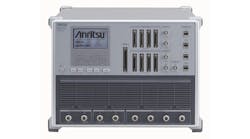To reach category 6 carrier-aggregation peak-downlink data rates of 300 Mb/s, a Long Term Evolution (LTE) network simulator should be capable of testing under a variety of conditions. It also must be capable of dynamic scripted protocol-level testing, as opposed to the replication of static conditions. Utilizing these techniques, a simulator-modem combination was recently demonstrated for a category 6 device using 20+20-MHz carrier aggregation.
Specifically, Anritsu’s MD8430A LTE simulator and Qualcomm’s Gobi 9x35 modem supported category 6 carrier aggregation with two LTE frequency-division-duplexing (FDD) and time-division-duplexing (TDD) component carriers. Each covered up to 20 MHz. The system can be tested under bidirectional downlink/uplink traffic, RF impairments, and a range of secondary-component-carrier conditions. In addition, the implementation of hybrid automatic repeat request (HARQ) is enabled under high-throughput conditions.
The MD8430A simulator is scalable, offering five different models ranging from functional test models (FTMs) to performance test models (PTMs). With its built-in digital baseband interface, it vows to support stable LTE chipset performance and function evaluation tests—regardless of the performance of the RF section. Coding and decoding tests are supported by digital I/Q signals using a slow clock obtained by changing the clock frequency. Available software options for both LTE FDD and TDD are available for each model, enabling quick scripting of tests as well as layer 3 and lower-layer libraries.
The Gobi modem, which is the fourth generation of multimode LTE modems from Qualcomm, shows the mobile industry’s focus on supporting carrier aggregation to 40 MHz. Based on a 20-nm technology node, it offers backward support for other major cellular technologies including: dual-cell high-speed downlink packet access (DC-HSPA), enhanced voice-data only (EVDO) revision B, code division multiple access (CDMA) 1x, Global System for Mobile (GSM) communications, and time-division synchronous code division multiple access (TD-SCDMA).
